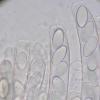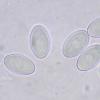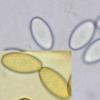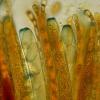
18-01-2012 09:54
 Illescas Tomás
Illescas Tomás
Bonjour:Quelqu'un a d'information bibliographique

15-01-2012 11:04
Alain BRISSARDBonjour à tousCette espèce de Sordaria, trouvée

14-01-2012 20:22
Dear friends, I would be very happy if somebody ha

10-01-2012 23:15
Ridha EL MOKNIBonsoir chers Mycologues,Je m'excuse pour avoir �

08-01-2012 18:20
Hi to all again:These nice stromata where collecte

16-07-2011 18:29
Tourbière, haute Ardenne. Par acquis de conscienc

07-01-2012 12:42
Bonjour à tous,L'un de vous aurait-il l'article s

25-11-2011 04:40
Ridha EL MOKNIGood morning every body, I am looking for some li
Peziza en restos coprófilos humanos. Ejemplares vistos, hasta 4 cms. Ascas monoseriadas, hasta 250 x 13 micras. Ascosporas nucleadas, sin gútulas, lisas inicialmente, con un fino punteado en la madurez, de 15-16 x 8-9.5 micras. Parafisis en palo de golf, septadas, con VBs, de hasta 6 micras de grosor. Excípulo medular de textura globulosa. P. perdicina (esporas14-16 x 7-8; en restos de animales), P. moraveci (13-15(16) x 6-8; excrementos de vacas), P. domiciliana (14-16 x 8-9; pero sin saber sustrato coprófilo). Descarto P. merdae por excípulo y ausencia de parafisis moniliformes............
¿Alguna idea más?
Peziza in dungs human remains. Seen, up to 4 cms. Asci up to 250 x 13 microns. Nucleated ascospores, without gútulas, initially smooth, with a fine stippling in maturity, 15-16 x 8-9.5 microns. Paraphysis in golf thick, septate, with VBs, of up to 6 microns. Medullar excípulum of globulosa texture. P. perdicina (spores14-16 x 7 - 8; in remains of animals), P. moraveci (13-15 (16) x 6-8; excrement of cows), P. domiciliana (14-16 x 8-9; but not know substrate of dungs). Don't think P. merdae by excípulum and absence of paraphysis moniliformes.
Any more ideas?







